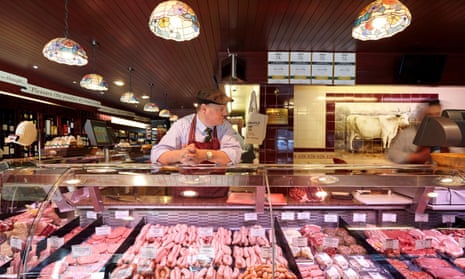What a time to be a butcher. With Veganuary in full swing and scientists delivering an onslaught of post-Christmas advice about the perils of meat eating, butchers are under pressure from all sides, caught in the cleft of consumer demands for better quality food at ever cheaper prices.
Take Robert Byford. A year ago, his shop in Leigh-on-Sea, Essex, was one of four serving a population that was enthusiastic about steak and bacon. Now Byford Food Hall is the last one standing.
“Where we are, three butchers have closed in the last 12 months,” Byford said, ticking them off: “One in Rayleigh is up for sale, another in Leigh has shut and there’s a third gone from Southend. They might sell it, but it seems unlikely. I think we’ll see more and more of this happening, just like the bakers and the fishmongers.”
Britain had about 15,000 butchers’ shops in 1990, a number that declined rapidly during the BSE crisis in the following decade and the outbreak of foot-and-mouth disease in 2001. By 2010 there were just 6,380, according to the Office for National Statistics, and now there are 5,830. About 100 shops a year are closing down without being replaced.
That decline may be speeding up again, and it certainly isn’t hindered by dietary advice such as that issued last week in the Lancet, by scientists suggesting people reduce their weekly red meat intake by 50%.
In November, Crawshaws, a chain of Midlands butchers, announced it was shutting 39 stores and went into administration to save the remaining 19. A month earlier Bristol lost JD Brittan, which opened in 1814 and served soldiers returning from the Napoleonic wars. Other losses include CD Field in Sedgley, West Midlands, gone after 116 years, Ron Reddy in Blackpool after 50 years and MS King in Bournemouth after 54 years.
Everyone has a different explanation. Some blame vegans – Pat Jenkins, a butcher of 60 years’ standing, thinks anti-meat publicity will see the end of her family-run shop in Bournemouth. Miranda Ballard agrees – her Muddy Boots chain of five premium butchers in London shut down just over a year ago.
“Vegetarianism was definitely part of it,” she said. “I was a big fan of meat-free Mondays, because I wanted people to buy better meat less often. We thought people wanted what they say they wanted, which is to pay more for great quality meat, but in the end their decisions are really about price and convenience. Every single time we opened a new shop, someone would come in and say ‘I’d forgotten what good meat tastes like’. That was great to hear, but it should have rung alarm bells for me. If people had forgotten, they weren’t going to come out of the supermarket to us.”

Others point to the familiar problems that beset the high street: rising rents, power bills and business rates, staff costs, the growing influence of the discounters Aldi and Lidl and the dominance of supermarkets.
“People don’t have the money,” said Asif Khan, who has worked at Pak Butchers in Walthamstow for five years. “In the last year people have started crying about the price. They never did that three or four years ago.” They import meat from Holland and other parts of Europe. “Prices have gone up. It’s Brexit.”
Perhaps the most worrying sign for the trade is the ageing profile of independent butchers. A survey by the Agriculture and Horticulture Development Board’s (AHDB) beef and lamb division in 2015 showed that 75% of butchers had been working for more than 20 years.
“Often what happens is someone wants to retire, their family don’t want to take it on and the shop shuts,” Robert Byford said. “Fortunately, we’re still going strong and my son’s involved in the business so when I retire he’ll take it on.”
Like many remaining butchers, Byford has moved away from tripe and offal to offer a touch of luxury. “You can’t beat the supermarkets on price,” he said. “We go for the quality end of the market. We do homemade pies. We cure our own bacon and smoke it in the shop. On Sundays we cook people’s joints for them, so they can go shopping and pick up their dinner on the way home.”
The “butcher-bistro” is increasingly popular. Hill & Szrok in Hackney, London, is a butcher’s during the day and a restaurant at night, while Michelin-starred chef Tom Kerridge created the Butcher’s Tap pub in Marlow, Buckinghamshire, with beef chillers turned into displays in the pub windows.
“The butchers that are left now are the good ones, the ones that fit with new consumer demands,” said Matt Southam of the AHDB. “There’s a lot of butchers doing rare breeds that you can’t get in a supermarket. We’re seeing a bigger link with farm shops too. It’s about connecting the supply chain from the farm gate to your plate.”
Despite the decline in butchers’ shops, the meat industry is still healthy, the AHDB says. While meat consumption has dropped by about 5% since 1995, last year saw a slight rise, with Britons spending £18.3bn. Those buying new vegan products such as ‘bleeding’ burgers and faux fish and chips tend to be meat eaters.
“When you get down to the pure numbers of people that are vegan, the numbers are very, very small,” Southam said. (The Vegan Society said in 2018 there are 600,000 vegans in the UK, just above 1% of the population; however, their numbers are growing.)
“What is having an effect is flexitarianism – those making a reduction, maybe one less meal a fortnight or one less meal a month. We just need to remind people that meat has minerals and nutrients that it’s hard to get elsewhere and it’s part of a healthy, balanced diet.”
